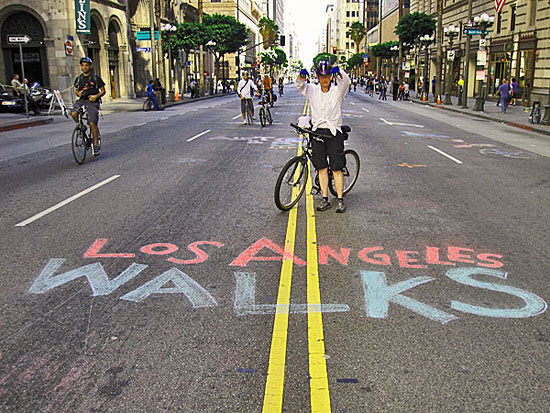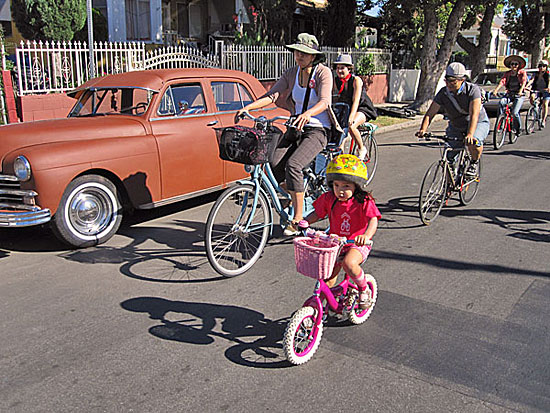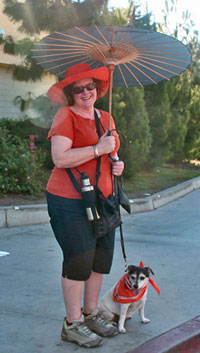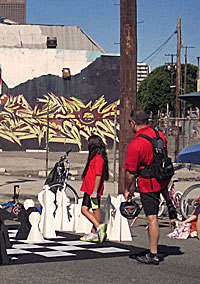Searching for CicLAvia’s slow gear
April 11, 2012

As pedestrians make their mark on CicLAvia, organizers urge cyclists to slow down and share the route.
If you go to CicLAvia this weekend, keep an eye out for Deborah Murphy.
She’ll be the one walking down the middle of the street with her Jack Russell terrier puppy, sharing her mantra with the sea of bicyclists around her:
“Slow down. Look around. Meet someone.”
Murphy, one of Los Angeles’ foremost pedestrian advocates, has walked in all three CicLAvias since the car-free street festival started here in 2010. She hopes that when the fourth gets underway at 10 a.m. on Sunday, April 15, she’ll see evidence that her message is gaining traction with the cyclists who make up 80% to 90% of the crowd.
“I want to believe it’s getting better,” said Murphy, founder of the advocacy group Los Angeles Walks and chair of the city’s Pedestrian Advisory Committee, who said she was alarmed the first time out by cyclists zooming downhill at one point along the route (where a “mandatory dismount” rule is now in effect.) “That’s not what CicLAvia’s about…This is a street party. This is not a street race.”
That sentiment is seconded by Josef Bray-Ali, the owner of the Flying Pigeon bike shop, who wrote a much-discussed blog post last April about taking his young daughter out on the route.
“This was the first time our 3-year old daughter had a chance to ride her bike in the street. The magic of that moment was ruined by CicLAvia participants on their bicycles riding by us on the left and right (while we were on the right hand shoulder of the street) going, frankly, too darn fast,” Bray-Ali wrote. “It is a perversion of the spirit of CicLAvia that the entire course is turned over to the fastest mode on the road…Let’s get this day right, Los Angeles!”
In other words, whose CicLAvia is it anyway? As the still-young event grows and changes, its identity is evolving as well—with a large and vocal cycling population reveling in having its own five-hour, 10-mile stretch of nirvana in an otherwise car-dominated metropolis, while an equally passionate walking community stands eager to claim its place on the pavement, too. The challenge of striking a balance stands as the price of success as CicLAvia comes of age.
With organizers expecting their biggest crowd of more than 100,000 on Sunday, such growing pains are proving somewhat ironic for the influential bicycle enthusiasts who started CicLAvia and view it as a key achievement in Los Angeles’ bike evolution.
“Every day of the week, we feel disrespected by cars. Let’s not be the oppressors,” said Joe Linton, a fulltime CicLAvia consultant and longtime L.A. cycling advocate. While he said that “99.9% of people have a great time at CicLAvia, whether they’re walking or biking, or 4 years old or 80 years old or 22 years old,” he said all participants need to bring mutual respect, common sense and a willingness to engage with each other.
“Everybody’s in this together,” he said. “Everybody needs to watch out.”
That said, cyclists’ passion for CicLAvia is so strong that it may tend to block out the possibilities for other ways to participate.
“We love that it’s an awesome bike event. There’s a sense that it’s so wonderfully ‘bike-y’ that people don’t realize they can do it in other ways,” Linton said. “We definitely are concerned about being inclusive.”
Pedestrians are welcome anywhere along the route, but first-timers might be especially comfortable strolling along Spring Street, Linton suggested. “It just feels really different. It’s quiet, you can see the architecture.” (Speaking of which, a new guide showcases the architectural and design high points all along the CicLAvia route.)
For novice cyclists, Linton has this advice: “Don’t bike all five hours. Stop for lunch. Don’t think of it as a workout; think of it as an exploration.”
The Los Angeles County Bicycle Coalition this week posted its own series of cyclist tips for riding safely and keeping an eye out for others.
Organizers say that the more CicLAvia becomes a street festival—with frequent musical, culinary and entertainment distractions—the slower the pace and the better for participants of all ages and experience levels.
So a key part of CicLAvia’s evolution has been to encourage dodge ball games, giant chess sets and movable photo booths, as well as musical acts and other spontaneous diversions along the route. REI will be sponsoring a climbing wall at the Hollenbeck Park hub, while the African American Firefighter Museum Hub on Central Avenue will feature museum tours, musical performances and a bike show starring the Real Rydaz Lowrider Bike Club.
Downtown, the Nature Conservancy will be raffling off two Schwinn-donated beach cruisers at 7th and Figueroa. It’s one of the organizations (others range from the Asian Pacific American Legal Center to the car-sharing service Zipcar) that will be “adopting” intersections and helping to manage bike-and-pedestrian flow through intersections which cars will be allowed to traverse intermittently. The groups will also be spreading their messages—an opportunity not lost on Los Angeles Walks, which has adopted 7th and Broadway.
The idea is to create an “intersection celebrating pedestrians,” L.A. Walks steering committee member Alissa Walker said in an email. On tap: “Lots of foot-friendly activity including double-dutch jump rope and hula hooping.” (Those inspired to help the group advance its pedestrian-friendly mission can do so even after CicLAvia is over by attending L.A. Walks’ karaoke fundraiser at Atwater Crossing on Saturday, April 21.)
Walker, a cyclist, pedestrian and blogger at Gelatobaby, concedes that she, too, was “a bit intimidated by all the bikes at previous CicLAvias.”
“But I think the best thing we can do is show all the different ways that streets can be used,” she said, such as a book club discussion she helped organize with L.A. Times architecture critic Christopher Hawthorne beside the 110 Freeway during last April’s CicLAvia.
This time out, she suggests pushing the envelope even further: “Grab some food to go and put a blanket out on the street.”
That’s right out of the playbook recommended by Flying Pigeon owner Bray-Ali, who blogged about the speeding cyclists last year. He thinks the best way to make CicLAvia evolve to become more inclusive is to harness more corporate sponsors to create crowd-pleasing digressions along the route and to find ways to make local merchants love it as much as the cyclists do. “Bring your bike and your wallet,” he suggests.
“It’s going to take work to make it work for pedestrians and people in walkers and wheelchairs, especially on the business side of things,” he said. “But that’s really when the power of the event takes over.”
And as CicLAvia grows, so do its participants, like Bray-Ali’s daughter, who’s now a road-tested CicLAvia veteran on a kiddie bike.
“Now she’s four, and she hauls,” he laughed. “Her bike is too slow for her.”

Valentina Bray-Ali leads the way to CicLAvia from her dad's Flying Pigeon bike shop. Photo/ubrayj02 via Flickr
Posted 4/10/12














 405 bridge work causes a stink
405 bridge work causes a stink

